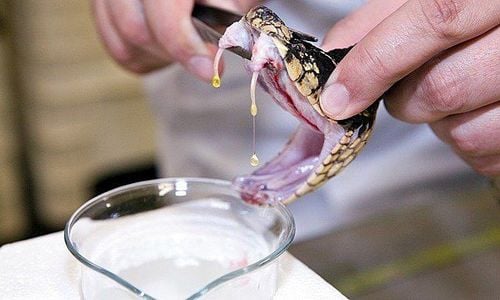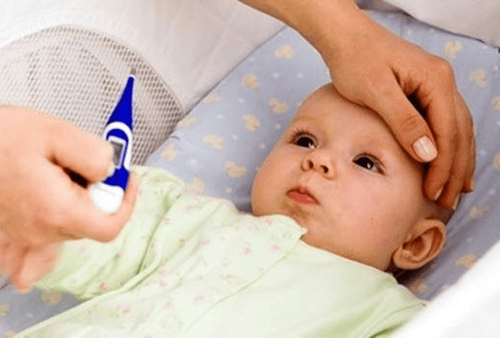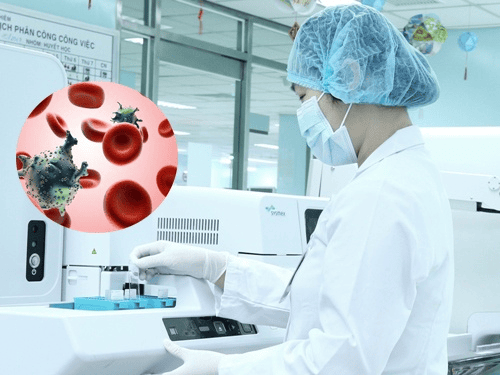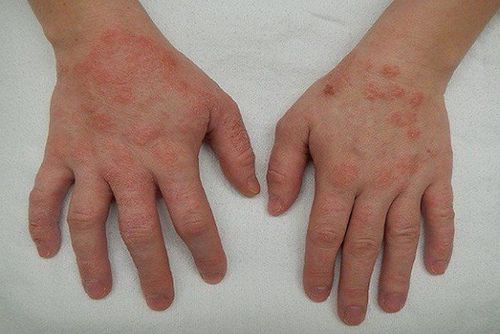This is an automatically translated article.
The article was professionally consulted by CKI Doctor Nguyen Thi My Linh - Department of Pediatrics - Neonatology - Vinmec Danang International General Hospital. Uncle has 12 years of experience in the diagnosis and treatment of pediatric diseases, especially neonatal resuscitation and neonatal treatment. In addition, the doctor has strengths in the field of breastfeeding counseling as well as examination, counseling and nutritional intervention in children.Newborn babies' immune systems are not fully developed to fight off pathogens, so they can develop infections after birth from various causes, postpartum infections if not detected and treated. Early treatment can seriously affect the health of the newborn, increasing the risk of postpartum mortality.
1. What is neonatal infection?
Neonatal sepsis are infections that occur from birth to 28 days of age. Neonatal infections can be caused by antenatal, intrapartum, and postnatal causes. Neonatal sepsis has the second highest mortality rate after neonatal respiratory distress syndrome.2. Why do newborns get infections after birth?
Newborns can be infected with bacteria after birth through the following ways:Cross the placenta (blood route): This is a way of transmission occurring before birth, often with agents such as congenital syphilis, HIV, rubella, cytomegalovirus. , toxoplasmosis Transmitted through membranes and amniotic fluid Transmitted by contact at birth: During delivery during pregnancy through the vagina, vulva, or infection sites in the uterus After birth, it may be due to exposure to infectious diseases infection in the community, especially in the hospital environment

3. Risk factors for postpartum infection
3.1 Risk factors from the mother Maternal infection during pregnancy (rubella, toxoplasmosis, cytomegalovirus...). Early rupture of membranes before 12 hours causes amniotic infection. Maternal fever before, during and after birth. Labor lasts more than 12 hours, especially over 18 hours. The mother had a UTI before giving birth without proper treatment or no treatment. 3.2 Risk factors from children Boys. Premature Babies. Low weight for gestational age. Obstetric trauma. Apgar index is low at birth (normally Apgar is 8-10 VND in the first minutes). 3.3 Environmental risk factors Direct or indirect transmission through mother, child's family members, medical staff Non-sterile medical equipment Invasive procedures (catheter placement, endotracheal intubation...) Do not wash your hands before touching the baby.. Through breast milk, secretions4. Identification signs

4.1 Early Neonatal Infection An early neonatal infection is an infection that occurs within the first 72 hours after birth.
Clinical symptoms of early neonatal sepsis may include:
Respiratory: Cyanosis, dyspnea, moaning, tachypnea > 60 breaths/min + traction, respiratory arrest > 15 seconds. Cardiovascular: Pale green, skin puffy, tachycardia > 160 beats/min, cold extremities, time to return to pink skin lasts > 3s, blood pressure drops. Digestion: Poor suckling, aborting, abdominal distention, vomiting, diarrhea, gastric juice stagnation > 2/3 of the amount of milk pumped before. Skin and mucous membranes: Pale skin, purple veins, rash, hemorrhage, early jaundice before 24 hours. pustule, edema, scleroderma. Nervous: Increased or decreased muscle tone, excitability, convulsions, fontanelle bulge, decreased reflexes, coma. Hematology: Death rash, subcutaneous hematoma, hemorrhage in many places, hepatosplenomegaly. 4.2 Late neonatal sepsis Late neonatal sepsis is an infection occurring 72 hours after birth. The main clinical forms are sepsis, meningitis, local infection
Clinical signs of late neonatal sepsis:
Sepsis: Symptoms are similar to early neonatal sepsis. Meningitis: May be isolated, unclear, persistent fever or unstable body temperature, altered consciousness, altered muscle tone, convulsions, excitability, apnea, crying, fontanelle, meningeal symptoms with or without, irregular breathing, vasomotor disturbances, vomiting. Skin infections can have the following forms: Pinhead-sized pustules, evenly spaced at first, then opaque. Dry acne leaves white flakes that easily peel off. The blisters are large and small, initially containing clear fluid, if infected, there is cloudy pus, broken, leaving a red background, clear fluid spreads around the new acne. Exfoliative dermatitis (Ritter's disease): Initially pustules around the mouth, then spread to the whole body, the epidermis is cracked and peeled, leaving a blood-soaked red slip. There are signs of high fever, dehydration, possibly with pneumonia, diarrhea, blood infection. Umbilical infection: Wet navel, red swollen, bruised, pus or blood, bad smell, swelling pulse, possible fever, poor appetite, abdominal distention, digestive disorders. Urinary tract infection: Usually jaundice. Necrotizing enterocolitis: Bloody stools, abdominal distension, vomiting. Mucosal infections include: Conjunctivitis: Children close their eyes, red eyelids, discharge or discharge pus. Oral thrush: The fungus is usually on the top of the tongue, at first it is white like milk residue, the fungus grows thick, spreads across the tongue, the inside of the cheeks down to the throat, the fungus turns yellow, causing pain to stop feeding. Can cause diarrhea, pneumonia if the fungus gets into the digestive tract and lungs.
5. Complications of postpartum infection
Neonatal infections that are not treated in time can lead to serious consequences such as:Affecting the child's growth and development in terms of nerves, senses, organs such as cardiovascular, respiratory .. In some cases severe postpartum infection can lead to death. Due to the weak immune systems of young children, they are not strong enough to deal with infections. Infection in infants is classified as a dangerous disease causing high mortality. When detecting that the baby has signs of suspected infection after birth, it is necessary to take the baby to a medical facility for examination and treatment. Early diagnosis, prompt treatment, and regular care and monitoring are the best ways to treat a child.
As a key area of Vinmec Health system, Pediatrics Department always brings satisfaction to customers and is highly appreciated by industry experts with:
Gathering a team of top doctors and nurses in Pediatrics : consists of leading experts with high professional qualifications (professors, associate professors, doctorates, masters), experienced, worked at major hospitals such as Bach Mai, 108.. Doctors All doctors are well-trained, professional, conscientious, knowledgeable about young psychology. In addition to domestic pediatric specialists, the Department of Pediatrics also has the participation of foreign experts (Japan, Singapore, Australia, USA) who are always pioneers in applying the latest and most effective treatment regimens. . Comprehensive services: In the field of Pediatrics, Vinmec provides a series of continuous medical examination and treatment services from Newborn to Pediatric and Vaccine,... according to international standards to help parents take care of their baby's health from birth to childhood. from birth to adulthood Specialized techniques: Vinmec has successfully deployed many specialized techniques to make the treatment of difficult diseases in Pediatrics more effective: neurosurgery - skull surgery, stem cell transplantation. blood in cancer treatment. Professional care: In addition to understanding children's psychology, Vinmec also pays special attention to the children's play space, helping them to have fun and get used to the hospital's environment, cooperate in treatment, improve the efficiency of medical treatment.
Please dial HOTLINE for more information or register for an appointment HERE. Download MyVinmec app to make appointments faster and to manage your bookings easily.














